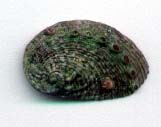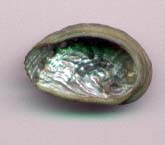Identification:
The particular tint of green coloration of the
shell is also very typical for H. pustulata/rugosa

 Click on images for a closer view
Click on images for a closer view
The width of the columella (the ridge along the
outer board of the shell when viewed from inside) is quite telling.
Similar species:
Haliotis pustulata; its
relationship to H. pustulata Reeve, 1846, is still debated,
i.e., are these two different species or just
one variable species? The distinction of the two taxa is the strength of
the spiral cording, which is pronounced in H. rugosa, but much weaker
in H. pustulata.
Haliotis clathrata; the
particular tint of green coloration of the shell is also very typical for
H.pustulata/rugosa,
but not that often seen in H. clathrata, where more red tones prevail.
The columella is quite a bit more narrow in H. pustulata/rugosa
than in H. clathrata. And many shells of pustulata have a bit of
a crucked growth, whereas H. clathrata is usually much more even.
H.
clathrata is a Pacific species. H. crebrisculpta Sowerby, 1914,
is the name that was most often associated with what is now
correctly referred to as H. clathrata
Reeve,1846 (non Lichtenstein,1794).
Breeding:
Habitat:
Distribution: Indian
Ocean (east African coast); H.
rugosa is particularly found on the Mascarene Isles (Mauritius and
Reunion Isles) and H. pustulata is found from the Persian Gulf,
the Red Sea down to the northernmost tip of South Africa. Main coast specimens
of H. pustulata tend to have stronger cording than the northern
specimens.
Food: algae.
Credits:
Identification of H. rugosa from these photographs and the information
in this database was provided by Daniel L. Geiger, University of Southern
California, Los Angeles.
Malacology
(Daniel L. Geigers Homepage) *** (with links to other sites)
Additional Information:
Some collectors use a name Haliotis form
lamellosa
rugosa Lamarck 1822 for a quite different Mediterranean Sea species.
Please note that there are two H. rugosa:
H.
rugosa Lamarck, 1822, and H.rugosa Reeve, 1846. The first is
the species featured and illustrated on this page, the second is a synonym
of H. tuberculata Linnaeus, 1758. Haliotis lamellosa has
also as author Lamarck, 1822,
Reports:
Richard Huggett (Eastbourne, UK) discovered
this abalone in his tropical marine aquarium in the autumn of 1997. He
grew it up from a minute seed abalone to a mid-sized adult 34 mm long by
the spring of 1999. The specimen had 16 holes.
EMail:
rich@huggett34.freeserve.co.uk
Please also send any replies to the BMLSS
EMail
Glaucus@hotmail.com
| Phylum: |
Mollusca |
| Class: |
Gastropoda |
| Order: |
Vetigastropoda |
| Family: |
Haliotidae |
For
more information on all the abalone taxa, please refer to Geiger (1998:
The Nautilus 111: 85-116)
Phylogeny
of Abalone
http://www.lam.mus.ca.us/~dgeiger/phylogeny.html
The
Epipodium of Abalone
http://www.lam.mus.ca.us/~dgeiger/epipodium.html
Green Ormer Database file
Haliotis tuberculata
